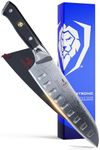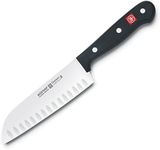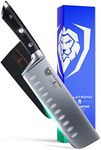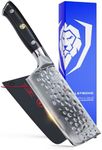Buying Guide for the Best Vegetable Knives
Choosing the right vegetable knife can make a significant difference in your kitchen experience. A good vegetable knife should be comfortable to use, sharp, and durable. When selecting a vegetable knife, consider the type of vegetables you frequently prepare, your cutting style, and your hand size. Here are some key specifications to help you make an informed decision.Blade MaterialThe blade material affects the knife's sharpness, durability, and ease of maintenance. Common materials include stainless steel, carbon steel, and ceramic. Stainless steel is resistant to rust and easy to maintain, making it a popular choice for everyday use. Carbon steel is known for its sharpness and edge retention but requires more care to prevent rust. Ceramic blades are extremely sharp and lightweight but can be brittle and prone to chipping. Choose a material based on your willingness to maintain the knife and your preference for sharpness and durability.
Blade LengthBlade length determines the knife's versatility and ease of handling. Vegetable knives typically range from 5 to 7 inches. Shorter blades (around 5 inches) offer better control and are ideal for precise tasks like peeling and slicing small vegetables. Longer blades (6-7 inches) provide more leverage and are suitable for cutting larger vegetables. Consider the size of the vegetables you usually work with and your comfort level with different blade lengths to find the right fit.
Blade ShapeThe shape of the blade influences how the knife performs different tasks. Common shapes for vegetable knives include straight, curved, and serrated edges. Straight blades are versatile and suitable for most cutting tasks, while curved blades are excellent for chopping and mincing. Serrated blades are useful for cutting through tough-skinned vegetables like tomatoes. Think about the types of cuts you frequently make and choose a blade shape that matches your cutting style.
Handle MaterialThe handle material affects the knife's comfort, grip, and durability. Common handle materials include wood, plastic, and composite. Wooden handles offer a traditional look and comfortable grip but require more maintenance to prevent damage from moisture. Plastic handles are durable, easy to clean, and often have ergonomic designs for a comfortable grip. Composite handles combine the benefits of both wood and plastic, offering durability and comfort. Choose a handle material that feels comfortable in your hand and suits your maintenance preferences.
Weight and BalanceThe weight and balance of a knife affect how it feels during use and can impact your cutting efficiency. A well-balanced knife with an even distribution of weight between the blade and handle provides better control and reduces hand fatigue. Lighter knives are easier to maneuver and are ideal for tasks that require precision, while heavier knives offer more power for cutting through tougher vegetables. Consider your strength and cutting style to find a knife with the right weight and balance for you.
Edge RetentionEdge retention refers to how long the knife stays sharp between sharpenings. Knives with good edge retention require less frequent sharpening, making them more convenient for regular use. High-quality stainless steel and carbon steel blades typically offer better edge retention compared to lower-quality materials. If you prefer a knife that stays sharp for longer periods, look for one with excellent edge retention. However, keep in mind that all knives will eventually need sharpening, so consider your willingness to maintain the blade.




















